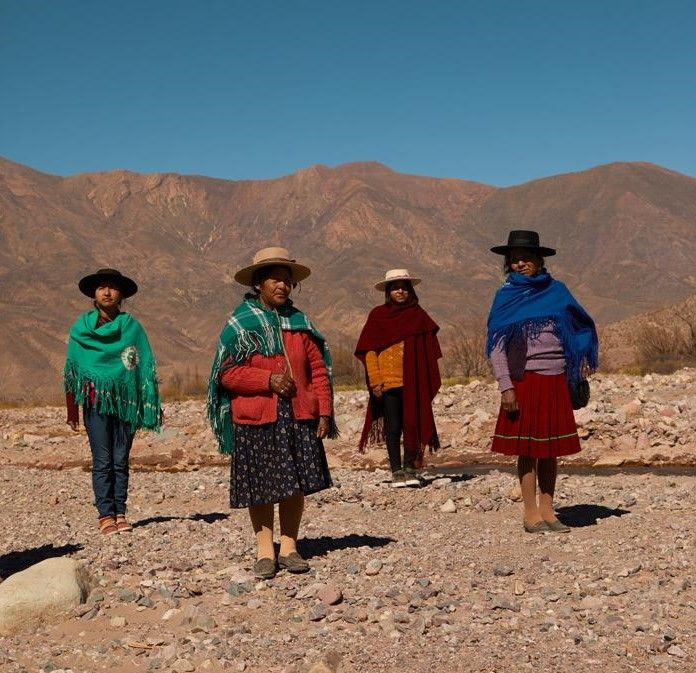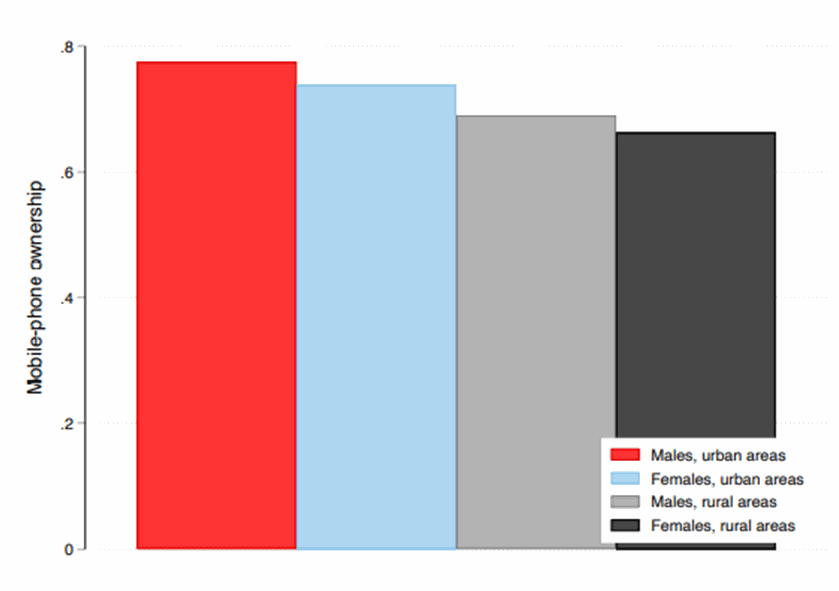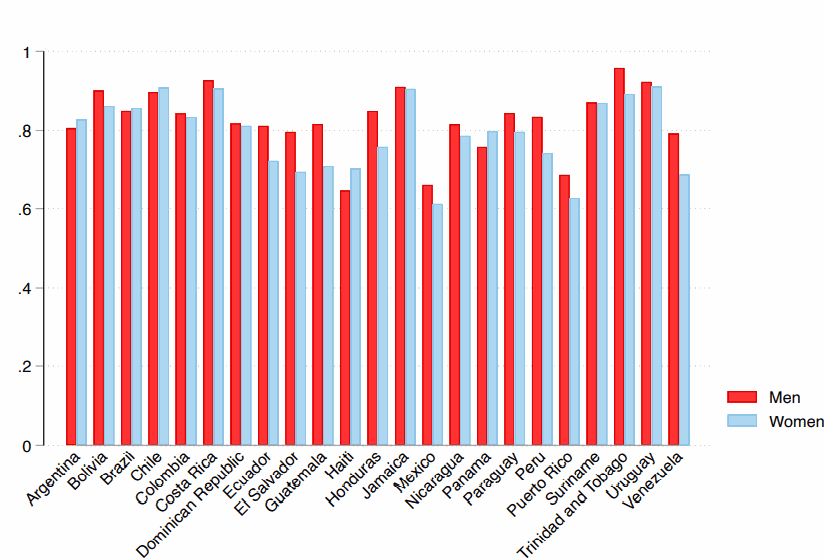Research study by the University of Oxford/IICA/IDB/IFAD
|
“In 17 of the 23 Latin American and Caribbean countries analyzed, the number of women who report owning a mobile phone is lower compared to men. The greater the gender gap with respect to mobile phone ownership, the lower women’s participation in the workforce. Rural women are the least connected group” |

In most Latin American and Caribbean countries, rural women are the group that is least connected to Information and Communication Technologies (ICTs), reveals our study sponsored by by the University of Oxford with support from the Inter-American Institute for Cooperation on Agriculture (IICA), the Inter-American Development Bank (IDB) and the International Fund for Agricultural Development (IFAD).
In the study “Digital rural gender divide in Latin America and the Caribbean”, based on data from the Gallup World Poll, information on the countries and digital trace data from Facebook, in 17 out of the 23 countries analyzed, we found that women are less likely to report to own a mobile phone compared to their male counterparts. Low-educated women living in rural areas are also the least “connected” group.
Fewer women than men report owning a mobile phone. However, this varies between rural and urban areas. Characteristics such as gender and household location of residence interact with each other producing multiple layers of disadvantage for women living in rural areas.
The topic of this study is particularly relevant amidst the Covid-19 pandemic, which has accelerated changes in production methods and marketing networks for all types of products, such as food and other goods supplied by rural areas.
|
“The study reveals that reduced access to mobile phones and the Internet is yet another issue faced by rural women, who must overcome greater obstacles to secure funding, receive training, access formal employment opportunities, and own land.” Manuel Otero, Director General of IICA |
INEQUALITY IN MOBILE PHONE OWNERSHIP

According to annual data from the Gallup Poll, mobile-phone ownership has increased from about 45% in 2006 to about 80% in 2017. The digital gender gap in mobile-phone ownership has narrowed over the past decade, yet with an apparent worsening over the past five years.
Although there are gender gaps in most countries, the study did identify some exceptions. While Argentina and Brazil have almost achieved gender equality, Guatemala and Peru are examples of countries with a wide gender gap. On the other hand, in countries like Chile and Uruguay, the female-to-male ratio tends to favor women.
The rapid diffusion of mobile phones has shown some promises in narrowing the digital divide and generating a positive impact on the economy and social development. For many people around the world, mobile phones constitute cheap, easy and effective computers, allowing not only to communicate and access information but also to obtain vital services linked to health, education, and the economy, or sell their products.
|
The multilateral funding institution “must spearhead efforts to expand opportunities for employment through digitalization in the region. The agency should “be at the forefront of efforts to expand connectivity in rural areas and to increase its use in education, small businesses, banking, and financing.” First speech as the new president of the IADB, Mauricio Claver-Carone |
Despite these advancements, women still often lag behind in digital access. According to the latest report released by the International Telecommunication Union (ITU), in most countries of the world women are still trailing men in benefiting from the transformational power of digital technologies: over half the total global female population (52%) is still not using the Internet, compared to 42% of all men”, according to data from the Gallup World Poll (2017) related to information provided by mobile phones.
The study explores the correlation between gender gaps in mobile-phone adoption and three measures of women’s empowerment utilized by the International Labour Organization (ILO), namely the ratio of female to male vulnerable employment rate, the ratio of female to male labor-force participation rate, and the ratio of female to male youth unemployment (measured in 2019).
The study concluded that, overall, a more narrowed digital gender gap with respect to mobile phone ownership is associated with better labor-market prospects for women and lower gender gaps in vulnerable employment and youth unemployment.
With respect to the use of social media platforms, the study utilized digital trace data on the gender composition of Facebook users (retrieved in February 2020) to measure the gender divide in social media use. Facebook was selected because it is the most popular social networking site in the region.
|
“Mobile phones can play an important role in reducing poverty and hunger, as well as in bridging the gender divide in rural areas. Rural women continue to be marginalized. Digital connectivity, through mobile phones, is critical to empowering these women, by granting them access to markets, information and financial services, particularly in the context of the Covid-19 pandemic. Lack of equitable access to mobile phones threatens to intensify the inequalities already suffered by rural women. If we do not resolve this problem, this gap could reverse the gains that we have worked so hard to achieve in terms of gender equality in rural areas, which would be to the detriment of rural development as a whole” Gilbert F. Houngbo, The head of IFAD |
The results show that, relative to countries in Sub-Saharan Africa and Asia, male and female Facebook penetration rates in Latin America are quite balanced, although there are some differences.
While in Brazil, Argentina, Venezuela, Colombia, Suriname, Uruguay and Paraguay, women are more likely to be Facebook users than men, in others, including Mexico, Nicaragua and Guatemala, men are slightly more active on Facebook.
The research study focuses on the first-level digital gender divide, which is the divide related to accessing ICTs, and highlights the need to conduct further research on the second-level divide, which relates to the skills required to better capitalize on these technologies.
The main findings of the study are:
- In Latin America and the Caribbean, there is a gender divide related to accessing information and communication technologies, which had been gradually decreasing up until a few years ago.
- Mobile-phone ownership in the countries analyzed has increased from about 45% in 2006 to about 80% in 2017.
- In 17 of the 23 countries analyzed, women are less likely to report to own a mobile phone compared to men.
- Women living in rural areas are the least “connected” group.
- In countries where the digital gender gap is lower, gender gaps in vulnerable employment, youth unemployment and labor-force participation are lower as well.
- Some countries, such as Argentina and Brazil, have almost achieved gender equality with respect to mobile phone ownership. In Guatemala and Peru, women are still at a disadvantage. In Chile and Uruguay, the female-to-male ratio tends to favor women.
COUNTRIES ANALYZED – MOBILE PHONE OWNERSHIP BY GENDER

Authors of the study
Valentina Rotondi (A social scientist with an interdisciplinary focus, Rotondi specializes in the interactions between population, development and technological change. A postdoctoral researcher at the University of Oxford, she holds a Ph.D. in Economics from the Catholic University of Milan).
Francesco Billari (A sociologist, Billari is a professor of Demography and Dean of that faculty at Bocconi University in Milan. A member of the Academy of Social Sciences of the United Kingdom, his field of research is population change and family dynamics).
Luca Pesando (Pesando holds a Ph.D. in Demography and Sociology from the University of Pennsylvania. A professor at McGill University in Montreal, he is also a researcher in the field of economic and social demography. His areas of interest include family poverty, inequality and stratification).
Ridhi Kashyap (Kashyap holds a Ph.D. in Sociology and is a Professor of Social Demography at the University of Oxford. Her areas of research include gender, mortality and health; the diversification of family formation patterns; and ethnicity and migration).
Note: The opinions expressed in this article are the responsibility of the authors and do not necessarily reflect the opinion of IICA.
|
If you have questions or suggestions for improving the BlogIICA, please write to the editors: Joaquín Arias and Viviana Palmieri. |
Añadir nuevo comentario